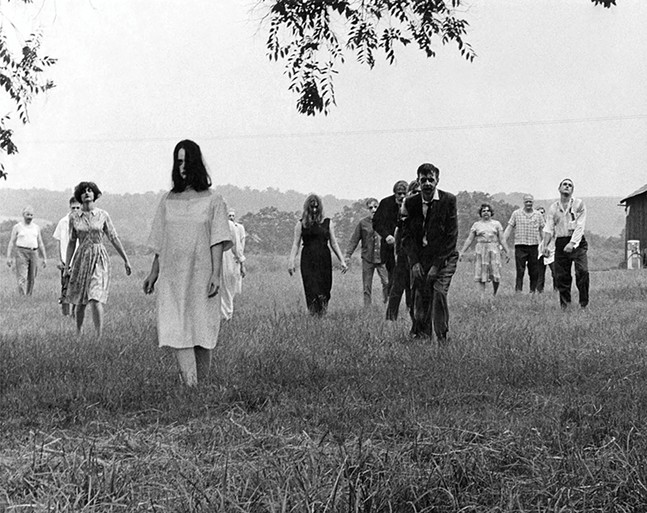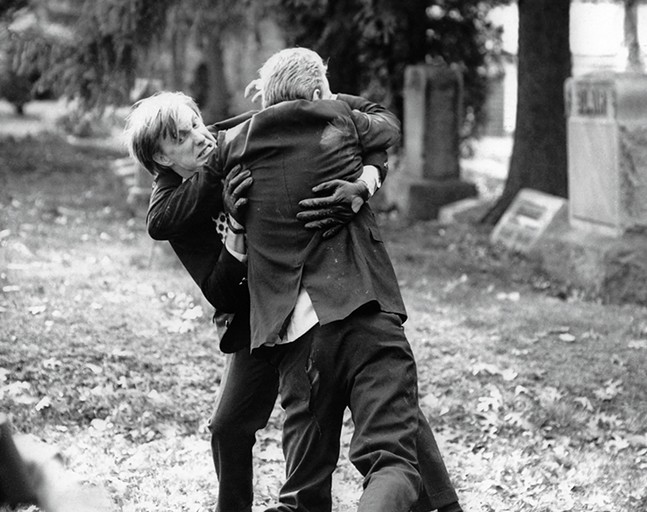In 1968, Night of the Living Dead made its world premiere at the Fulton Theater and put Pittsburgh on the film industry map. As the city prepares to celebrate Night’s 50th anniversary with a special screening and other events, City Paper spoke with three central cast and crew members about how they went from making commercials and industrial films for their small production company, Latent Image, to making one of the most influential horror films of all time.
The Beginning
Russell Streiner (co-producer/Johnny): George Romero was always our film spiritual guru. He had more experience than any of us. He moved here in 1958 to go to what was then Carnegie Tech. It was shortly after that, within a few months, that I first met him that we became friends. We worked on a couple small things together and decided we should form a company, the Latent Image.
By the mid-60s, we were successful enough to expand our staff to people like John Russo, my brother, Gary Streiner, and Vince Survinski, our business manager, all with the general idea that we’re going to be able to save up money and enough equipment to do our own feature.
Gary Streiner (sound engineer): Russ asked to come out to Schenley Park one Saturday afternoon to be an extra in a film they were shooting. That was my first real entrée to the film business, and I thought, "I really like this."
I think I started at Latent Image in 1964. That would have been three or four years before we started working on Night. I graduated in 1965. I went to school for half of the day, and worked for the second half of the day. I never made it to college. I did this straight out of high school. Latent Image, Image Ten, and Night of the Living Dead – that was my first real job.
John Russo (co-writer/ghoul): We’d done dozens if not hundreds of industrial films and commercials, so we learned everything from the ground up. We wanted to be feature filmmakers. The commercial stuff was just a stepping stone to help build up our studio and our equipment and everything else. George, Russell, and I were all the same age, about 27 years old, when we shot the movie.
Russell Streiner: The one project that tipped it over the edge for us was we were hired by an advertising agency to do a series of tourist promotional films for the Commonwealth of Pennsylvania to promote the fall foliage, and the requirement was that we use 35mm film. Up until that the majority of our commercial work was 16mm. That was in 1966. With that camera that we were kinda forced to buy for that commercial project, that was the camera that then filmed Night of the Living Dead.
Gary Streiner: We were very lucky to be able to be making a living off of TV commercials in Pittsburgh, but at some point in time, particularly with an energy like George’s, we wanted to do our own thing … WIIC Channel 11 at the time had bought a package of five horror films. This was even before Bill Cardille was at the station and doing the midnight horror show. And Russ and George watched the first one on the night it premiered and basically said, “We can do better than that.” That was kind of the impetus.
Russo: Eventually, we decided we better do a horror film because that’s probably all we could afford to do … Since George and I were the two writers, we started throwing ideas around. Eventually, we decided we better do a horror film because that’s probably all we could afford to do. And I said whatever kind of script we came up with it probably should start in a cemetery because people find cemeteries spooky ... My idea was that aliens had come to earth in search of human flesh. You didn’t need to see them land or anything, you know, because that would have been too expensive back then. I told George about that idea and he came in with about 20 to 30 pages of a story where this girl and her brother go to put a wreath on a grave and the girl’s being chased and the brother’s head had been bashed against a tombstone and so on. I read it and I said, “This is good, it has all the right twists and turns and suspense, but you don’t say who’s chasing this girl.” And he said, “I don’t know.” And I said, “It seems to me while I was reading it that they could be dead people.” He said, “That’s good.” And I said, “You don’t say what they’re after either … Why are they chasing her?” Again, he said he didn’t know. So I said, “Why don’t we use my flesh-eating idea. And he said, “That’s good.” That’s how they became dead people after human flesh.
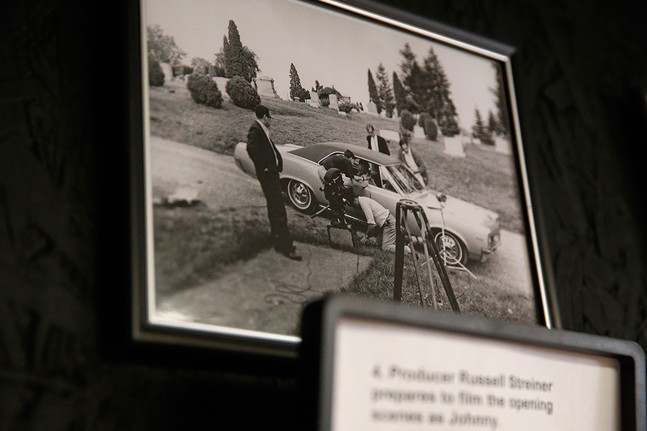
Casting
Russo: We enlisted Karl Hardman and Marilyn Eastman right away. Their company was Hardman & Associates, which was mostly sound production on Smithfield Street, but they acted in commercials that we made, so we knew they could act. They worked their butts off and were really key people all the way through.
Russell Streiner: Karl Hardman and Marilyn played Harry and Ellen Cooper, and Karl’s real daughter, Kyra Schon, played the young girl in the film, simply because Carl was deeply involved in the production and he sort of quasi-volunteered his daughter to play the Karen part.
Duane Jones was originally from just outside of Pittsburgh in Duquesne, but none of our group knew Duane at the time. He had already moved New York City, where he was teaching acting and acting in theater. By pure happenstance, a mutual friend knew Duane from New York. Duane came back to visit his family in the Easter of 1967, and she said, “Our friends are making a film. They’re about to start in the summer. While you’re at home, why don’t you audition for them?” As it turned out, he was the absolute best choice to play the Ben character. Up until that time, a friend of ours, Rudy Richie, was scheduled to play the Ben character, but once we saw Duane’s audition, even Rudy was in favor of casting Duane.
Maybe in our subconscious minds somewhere we thought it was a little bit risky, but I have to say in all honesty that Duane was cast simply because he was the best actor, and by coincidence he was African American. We did know that by casting an African-American actor that there would be some parts of this country that would probably not be interested in showing our film … We didn’t think about that. Duane was the best actor, so Duane got the job.
Russo: At first, I was going to be the ghoul in the cemetery. I got into that makeup … and then [Bill Hinzman] showed up and he had a black suit. He was very gaunt in those days, so he became the cemetery ghoul.
Then nobody was around when we were shooting the scene where I fight with Duane. So I got in that same makeup again and did that part. At that point I didn’t do a lot of acting … I thought [ghouls] would have some degree of rigor mortis so I moved like I had rigor mortis. In addition to the makeup, I stretched my face out of shape. I ended up with a headache from doing that after a number of takes.
Whenever Duane is gonna drag me out and Judy’s catatonic and staring down at me, people often ask, “Why did your eyes move?” I thought it would be spooky. [Laughs] I wasn’t necessarily completely dead. I thought about one time I was in a motel and it turned out to be a dive. I smashed a cockroach against the wall and the thing was still moving. The bottom half was plastered to the wall and the top half, the damn thing was still moving. So I figured my eyes would be moving.
Russell Streiner: Judith O’Dea was a performer who had been working in various Hardman productions. She and I looked enough like brother and sister, so it made logical sense that I would play her brother.
The Shoot
Gary Streiner: We probably had about five crew members that actually shot the film … If I wasn’t being the sound man, I was loading magazines of film and assisting the cameraman. We all covered a lot of different bases on Night.
Russo: The script called for the farmhouse to have a fireplace, which it did not have, and Vince made a hearth for the fireplace. The door that leads to the basement, he cut that hole in the wall and made that door. The farmhouse had no basement. So the basement was the basement of our building on Fort Pitt Boulevard.
Gary and I took the truck and filled it with furniture from Goodwill for $50. We dragged carpets and every damn thing there. I think it was [Hardman's] radio and somebody brought a music box. I brought a Victrola … Everybody contributed.
Russell Streiner: F. Jack Napor and WRS film lab had worked on Night of the Living Dead with us, doing the processing of the film and that kind of thing. We were always short of cash. Napor was new to playing chess and I wasn’t very good myself, but I was a little better than Jack. One night, we were having some cocktails in Oakland at a bar very near the lab. He said, “I’d really like it if you could promise me that you will make an all-out effort to whoever the distributor of this film is, that you put on a big push for us to be the lab that makes all the release prints.” I said, “I can do that, whether I’ll be successful or not is another matter.” And so one thing led to another and he said, “Maybe we need something that is more concrete. How about if we play chess and whoever wins will solidify our gentlemen’s handshake?” I said, “If you lose what do I get?” And he thought about it for a minute and said, “The lab will provide you with the completed mix of the soundtrack and the optical track to go with it.” It was no lose situation for me, because I would have promoted WRS to get the print order anyway just because it was a Pittsburgh company. We played chess. He lost. He was a gentleman and indeed all the costs related to the final sound mixing and optical track, they provided. We put forth our best effort to get them the release print order, but the distributor had their own agreements with labs in NY, so we were not successful in getting WRS the release print order.
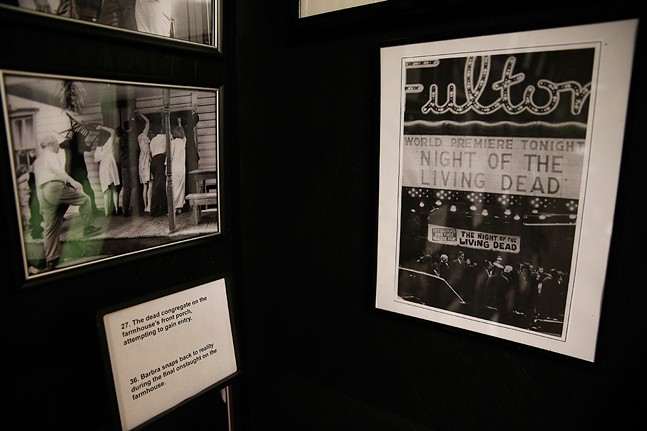
The 1968 Pittsburgh World Premiere
Russell Streiner: By April 1968, we had a finished piece that we could actually take to show other people, as a producer, I started to make contacts in the film distribution world in NYC, and made appointments. Then George and I were driving to NYC with the finished 35mm print. It wasn’t called Night of the Living Dead then, it was called Night of the Anubis … We completed the distributor screenings that we had set up for that trip, and got surprisingly got a good response, with the caveat that the title had to change. Very few people knew that Anubis was one of ancient Egyptian gods of the dead, and it had to be something much more commercial.
Russo: [The Fulton Theater] was totally packed. Russ and I handled all of the promotion of it. We didn’t trust that the distributor would do anything, which they didn’t. And so we went with klieg lights and red carpets and limos and the whole damn thing. People ate it up. The movie got a standing ovation in a packed theater and it took off.
It was in 17 drive-in and neighborhood theaters in Pittsburgh … There were a lot of drive-ins up and down Route 51 and the people trying to get into the drive-ins were lined up on the main highway because they couldn’t get in.
When we went to New York with it and Variety gave it a terrible review. [Laughs]
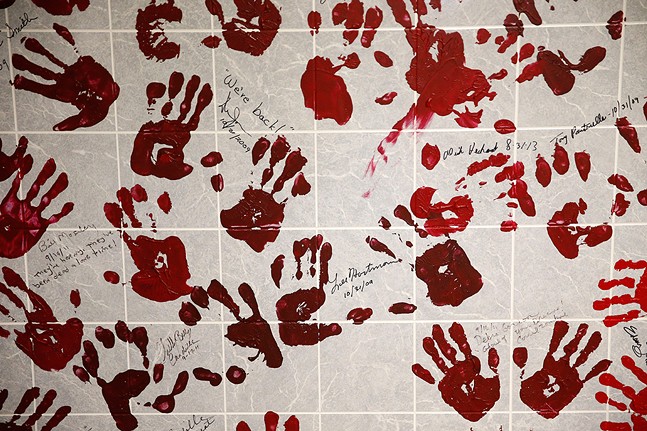
On the Museum of Modern Art and 50th Anniversary
Russell Streiner: George was present, along with Gary and John Russo and me and our wives, at the MOMA premiere of the film. We were asked to make a few remarks … George stood up in front of the audience at MOMA and said, “I can’t believe it. If you knew all of the back story of how this project came to be, it is highly improbable that we would be standing here in the MOMA among an audience like this of people recognizing our film.” And he was genuinely impressed that our modest little Pittsburgh picture had achieved such acclaim … After he made these remarks of astonishment, I think he followed it up with, “What’s wrong with you people?” [Laughs]
__
Russell and Gary Streiner and John Russo will appear at Living Dead Weekend. The event begins on Friday, Oct. 5 and continues through Sunday, Oct. 7. 154 W Main St., Evans City. $20-140.

